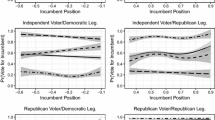Abstract
This paper presents a new approach to spatial models of legislative elections in which voters have preferences over the bundles of roll call votes implied by candidate locations rather than over the locations themselves. With such preferences, voters with single-peaked, symmetric preferences and perfect information can sincerely prefer a distant candidate to a more proximate candidate. Moreover, negative agenda control in Congress makes such preference orderings inevitable, so party agenda control can allow majority party extremists to defeat more centrist minority party candidates. The model has implications for theories of parties in Congress, and spatial modeling more broadly.
Similar content being viewed by others
References
Aldrich, J. (1983a). A spatial model with party activists: implications for electoral dynamics. Public Choice, 41, 63–100.
Aldrich, J. (1983b). A downsian spatial model with party activism. American Political Science Review, 77, 974–990.
Ansolabehere, S., Snyder, J. M. Jr., & Stewart, C. III (2001). Candidate positioning in U.S. House elections. American Journal of Political Science, 45(1), 136–159.
Austen-Smith, D. (1981). Party policy and campaign costs in a multiconstituency model of electoral competition. Public Choice, 37, 389–402.
Austen-Smith, D. (1984). Two-party competition with many constituencies. Mathematical Social Sciences, 7, 177–198.
Austen-Smith, D. (1986). Legislative coalitions and electoral equilibrium. Public Choice, 50, 185–210.
Besley, T., & Coate, S. (1997). An economic model of representative democracy. Quarterly Journal of Economics, 112, 85–114.
Brady, D. W., Han, H., & Pope, J. C. (2007). Primary elections and candidate ideology: out of step with the primary electorate? Legislative Studies Quarterly, 32, 79–106.
Cadigan, J., & Janeba, E. (2002). A citizen-candidate model with sequential elections. Journal of Theoretical Politics, 14(4), 387–408.
Canes-Wrone, B., Brady, D. W., & Cogan, J. F. (2002). Out of step, out of office: electoral accountability and House members’ voting. American Political Science Review, 96, 127–140.
Cox, G. W., & McCubbins, M. D. (1993). Legislative leviathan. Berkeley: University of California Press.
Cox, G. W., & McCubbins, M. D. (2005). Setting the agenda. Cambridge: Cambridge University Press.
Downs, A. (1957). An economic theory of democracy. New York: Harper Collins.
Enelow, J. M., & Hinich, M. J. (1982). Nonspatial candidate characteristics and electoral competition. Journal of Politics, 33, 115–130.
Fowler, L. L., & Frederking, B. (2000). Representation, careerism, and term limits: a simulation. In Bianco, W. T. (Ed.), Congress on display, congress at work. Ann Arbor: University of Michigan Press.
Hacker, J., & Pierson, P. (2005). Off center. New Haven: Yale University Press.
Jacobs, L., & Shapiro, R. (2000). Politicians don’t pander. Chicago: University of Chicago Press.
Jessee, S. (2009). Spatial voting in the 2004 presidential election. American Political Science Review, 103(1), 59–81.
Klumpp, T. (2007). Strategic voting and conservatism in legislative elections. Unpublished manuscript.
Lacy, D., & Paolino, P. (1998). Downsian voting and the separation of powers. American Journal of Political Science, 42, 1180–1199.
Osborne, M. J., & Slivinski, A. (1996). A model of political competition with citizen candidates. Quarterly Journal of Economics, 111, 65–96.
Persson, T., & Tabellini, G. (2000). Political economics. MIT: Cambridge.
Poutvaara, P. (2003). Party platforms with endogenous party membership. Public Choice, 117, 79–98.
Rabinowitz, G., & MacDonald, S. (1989). A directional theory of issue voting. American Political Science Review, 89, 93–121.
Schattschneider, E. E. (1960). The semisovereign people. New York: Harcourt Brace.
Stokes, D. (1963). Spatial models of party competition. American Political Science Review, 57, 368–377.
Van Houweling, R. (2003). Legislator’s personal policy preferences and partisan legislative organization. Doctoral dissertation. Harvard University.
Wittman, D. (1977). Candidates with policy preferences: a dynamic model. Journal of Economic Theory, 14, 180–189.
Wittman, D. (1983). Candidate motivation: a synthesis of alternative theories. American Political Science Review, 77, 142–157.
Zakharov, A. V. (2009). A model of candidate location with endogenous valence. Public Choice, 138, 347–366.
Author information
Authors and Affiliations
Corresponding author
Rights and permissions
About this article
Cite this article
Buchler, J. The proximity paradox: the legislative agenda and the electoral success of ideological extremists. Public Choice 148, 1–19 (2011). https://doi.org/10.1007/s11127-010-9643-4
Received:
Accepted:
Published:
Issue Date:
DOI: https://doi.org/10.1007/s11127-010-9643-4




